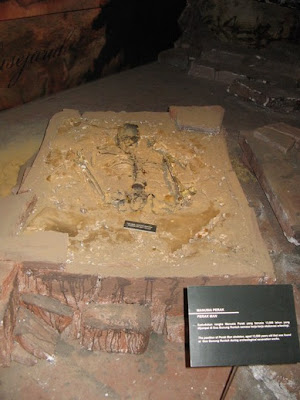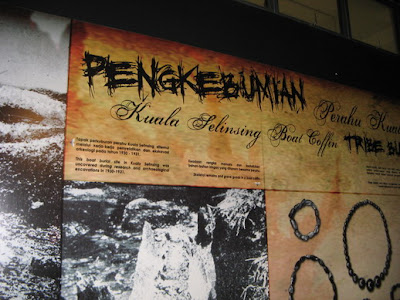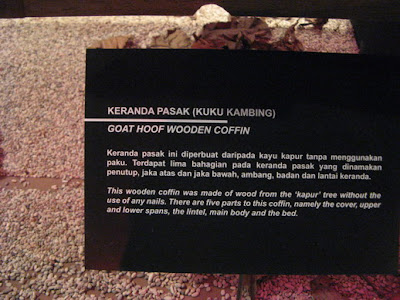
This exhibition depicts coffins and burial rituals from southeast Asia. It is at Muzium Negara, the National Musuem in KL, and is held in the exhibition hall until 18 July 2010. Entry is RM2 and you are allowed to take photos. Apparently there is a RM3 camera fee but I wasn't asked for this!

It starts with the archaeological section, with the hall designed to look like a cave with a wooden plank walkway. This was the most interesting for me, as it showed cave burials - Neolithic & Hoabinhian burials from Gua Cha, Perak Man, Niah Cave, etc.

Gua Cha Neolithic
& Hoabinhian

Perak Man, above and below -



Boat coffins are also featured, such as those from Kuala Selinsing in Perak, and from Niah Caves -








Jar burials started in Neolithic times, and the jars were placed in caves or even in trees. Niah jars -

Stone slab burials have been found from various sites in Perak.

There is a section on burial and funeral customs relating to orang asli - the temiar wrap the body in a mat and carry it in a bamboo cylinder to the burial site. Mah Meri use wooden planks and bamboo coffins.

animal head


Temiar bamboo litter, and Semai & Temiar grave (below)


Bateq place the wrapped corpse in a tree platform.

Mah Meri
The exhibition then turns to the modern ethnic/religious burials. Different Muslim burials are described - generally the Malay community does not use a coffin, except for the east coast coastal regions, as the sandy and marshy areas are not suitable for cavity burials. The coffins are plain with no decoration. There is a hand drawn hearse


Muslim bathing ritual


bamboo litter

Muslim footed wood coffin
Some Muslim wood coffins -


The Indonesian section shows the buffalo shaped coffins. The notice board also mentioned some with a pig motif, but no example was shown!

buffalo coffins from Indonesia

Coffins from Thailand weren't so well represented, with only a single notice board, with examples of a child's coffin -


Kalimantan Dayak coffin
modern Indian coffin
Hindu and Chinese get a small section, but I don't recall seeing much, if anything on Christian burials. There is a gold plated Chinese coffin.
Different tribes and areas from Borneo are represented, including a log coffin from a Sabah cave, and jar burials. There is an elaborate seladang shaped coffin from Sabah - these coffins have survived quite well as they are made of hard wood such as belian and were stored in caves.



ornate Kelabit coffins
Kelabit jars -


kinabatangan log coffin





Philippine burials are represented by a jar and also a rattan chair - the corpse is left to rot on the chair and later the skeleton is stored in a jar. The body fluids are collected in a basket under the chair and are dabbed onto family members for blessing.
Quite an interesting assortment of burials.
© Liz Price
No reproduction without permission

No comments:
Post a Comment